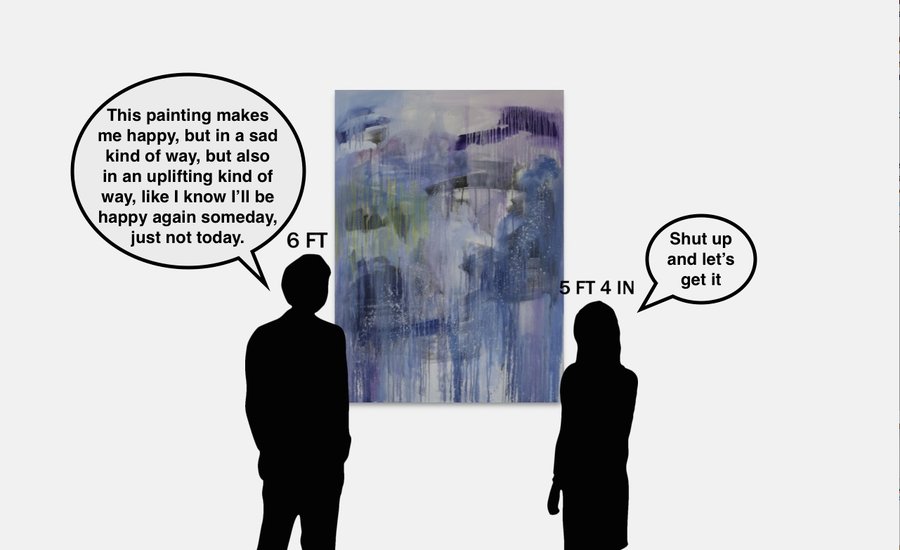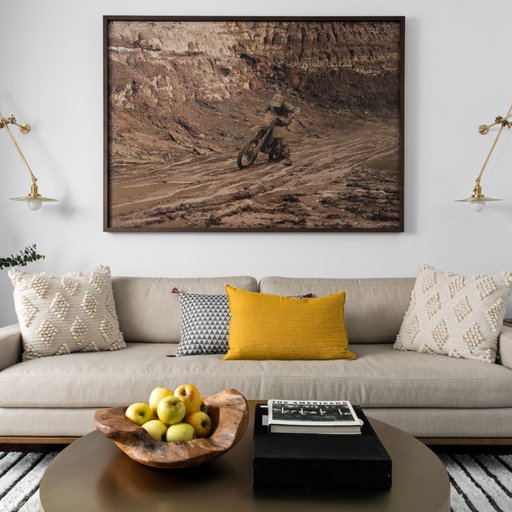So, you want to buy some art. Okay. Take a breath. Limber up. Blink a few times. You’re going to want to have your eyes fresh, because you’re looking for something that only you can identify: an artwork you love.
Luckily, buying art, while often said to be an elite activity for ironical Europeans clad entirely in black, is actually not that hard—especially if you break the process down into its component steps. Call it the K.I.S.S. method. (Keep it simple, Saatchi-in-training.)
First of all, if you’re an art addict who collects for the pure acquisitive thrill of the hunt, you probably don’t need help here—you know the artists you’re interested in, so you can just go to their pages under the “Artists” menu and pick from what we have. (Don’t see what you want? Contact our Member Services desk and we can probably track it down for you at a good rate.)
On the other hand, if you’re a typical art buyer—like most of us—you probably have a particular space in mind (in your home, office, friend’s embarrassingly boring apartment, et cetera) that you’re trying to fill, and a fairly well defined budget on which to fill it. Here’s where we get to those component steps, each of which you can easily use to personalize your search on Artspace’s “Browse Art” page. Let’s walk through them one by one.
PRICE
Tough love time: art isn’t cheap. But, then again, it doesn’t have to be unheard-of expensive. So, if you want to buy a print or an edition, you can get something good for the price of a fancy dinner for two at a special-occasion restaurant, with wine (say, $300 to $500). If you want to buy a unique piece—i.e., a painting or a sculpture—understand that your entry level is going to be somewhere around the price of a nice suit or handbag, $1,000 to $2,000.
Remember that art is a luxury good like any other, and that you actually want it to hurt a bit to buy it, since that imbues it with extra personal value and meaning. All of this is to say, a good first step is to set a price range in which you’re willing to spend (giving yourself a little wiggle-room on either side for the perfect find). Then simply plug these parameters into the filter on the top of the left-hand rail on the “Browse Art” page.
MEDIUM
Maybe you’re medium-agnostic and don’t care what form your art takes, so long as it resonates with you. Bravo! You’re an enlightened aesthete—we salute you, and you can just happily meander through the “Browse Art” section and wait to be seduced. Different mediums, however, do have different appeals, and can be searched individually to meet a range of needs.
Prints and editions, for instance, are an excellent way to buy work by an artist you love at the most accessible price possible—for obvious reasons, most people go with these, and we have a whole range of Artspace Editions that we produced in collaboration with artists (and can offer for a good value). Artist-designed objects, on the other hand, are an even more affordable way to get something by a renowned artist, though they aren’t technically art (and might even be functional). You'll find these in our Design Store.
Photographsare excellent wall-fillers that come at a wide range of price points (depending on the artist and edition size, with the ones with fewer editions being more expensive and “fine-arty,” and then certain recent abstract photographs occupying the same status as paintings).
When you get to unique artworks, which for many people are the most desirable (an amazingly talented artist made something just for you!), drawings and works-on-paper are a smart and tasteful way to get in at a low price. Painting and sculpture, of course, are the big kahunas—the most efficiently impressive works of art that you can own, in that they make an unforgettable impact while being pretty easy to live with.
Finally, new media and videoart are mainly reserved for the most advanced collectors, since they require extra care and upkeep as well as a dedicated space where they won’t be distracting during your non-art moods.
To hone in on a particular medium, simply click the relevant boxes on the “Browse Art” page to narrow your search.
SIZE
Size matters! If you know where you want to display the piece, that already gives you some spatial constraints to work with, which can be helpful in refining your search. (Generally speaking, you also want to give your art some room to breathe, unless you’re going for a tight salon-style hang.) Happily, size is the most straightforward criterion for an art purchase, and we here at Artspace have two tools to help you spec things out.
The most basic of these is the View in a Room function on the artwork page on our website, which allows you to see how large a piece will be on your wall in proportion to your average viewers, rendered as a 6' man and a 5'4" woman, both all in black and probably ironic and European.
Then, for a more high-tech (and useful) approach, download the Artspace app and use its “View in My Room” feature—it will let you virtually project an artwork onto your wall, so you can see what it would look in proportion to your actual space. It really helps!
COLOR
When it comes to the optimal color of an artwork, there are many schools of thought. From a market standpoint, artworks presenting the three primary colors—yellow, red, and blue—are reputed to be the most popularly appealing, with red being the most seductive when it comes to sales. (“It varies from artist to artist,” Sotheby’s specialist Philip Hook once said, “but I think red is probably the most desirable color you can get in art, full stop.”)
Within these parameters, there are further points of view. “Generally speaking, paintings with light colors sell more quickly than paintings with dark colors,” John Baldessari wrote in his humorous painting Tips for Artists Who Want to Sell (1966-1968). German’s Der Blaue Reiter group held that blue was the most spiritual color; Wassily Kandinsky, its most celebrated member, believed heaven to be blue. Joseph Albers, the legendary artist and color theorist, taught his pupils that true beauty could only be achieved through a harmonic blend of colors. The Rolling Stones, meanwhile, had a different suggestion for artists: “Paint it black.”
This, of course, is all silly, and beside the point. The color of the artwork you buy should be an expression of your personal taste—everyone’s a hopeless sucker for one hue or another—and an attempt not to make your home unlivably garish. The safest bet? Let an artist’s themes and style connect with you first, then select a color almost as an afterthought. This way you can taste the rainbow.
SUBJECT MATTER
Every artist is trying to do something with their art—to convey a concept, situation, or state of mind that they find urgently compelling to the viewer. Some artists want to shine a light on an injustice; others hope to provoke titillation, or shock; still others may simply wish to have a conversation with their chosen medium, trying to get a word in edgewise when it comes to the legacy of its great masters.
This is the place where your role is to be the audience for the artist and to let them rivet you, like the person on the receiving end of one of those charismatic orators who makes you feel like you’re the only person in the room. With more difficult or conceptual artists, work is often required on your part to be able to receive the work—and this can lead to a deeply satisfying engagement with a piece that will become more enriched over time.
To gain this kind of insight, just go to the artist's Artist Page, where you can read a synopsis of their biography and find a primer on their presiding themes. See if we've done one of our famous interviews or other coverage with them on Artspace Magazine (they'll be listed at the bottom of the Artist Page)—reading these will allow you to absorb their thinking in depth.
But if an artist’s subject isn’t reaching you, despite giving it a good-faith effort and doing your due dillegence, then move on. It’s probably just not for you.
STYLE
When you’re listening to a great piece of music—by the Rolling Stones, say—the lyrics are the subject matter, and the choice of instruments, rhythm, tempo, melody, and overall vibe is the style. Abstract art is pretty much all style—its formal elements, in other words, are its subject matter. And style is what makes the world go 'round when it comes to art. Jasper Johns has one of the all-time great quotes when it comes to the topic: “Style is only common sense. You figure out what people like about you, and you exaggerate it.” If you like an artist, then you really like their style.
Some styles, meanwhile, lend themselves to certain uses. Geometric Abstraction is exceptional for décor if that's what you're looking for, while black-and-white photography is typically can't-fail elegant. You can browse these kinds of broader style categories on Artspace's "Browse Art" page, simply by scrolling down to the bottom of the left-hand rail. You can also find other examples of a similar style by clicking on a work and navigating via the Tags at the bottom of the right-hand side of the page.
The danger with style comes when you’re concerned about a kind of artistic approach being outmoded, as so often happens in today’s art world. Process-based abstraction, aka Zombie Formalism? So 2015. But just remember: paying attention to fashion is the world’s worst way to choose an artwork. If something’s good, it doesn’t matter what people are saying about the reputation of the aesthetic approach the artist took—it’s just good, and if you give it time, people will hail it as good again, and praise your connoisseurial eye. So just stick with what you like. As Yves Saint Laurent said, “Fashion fades, style is eternal.”



























